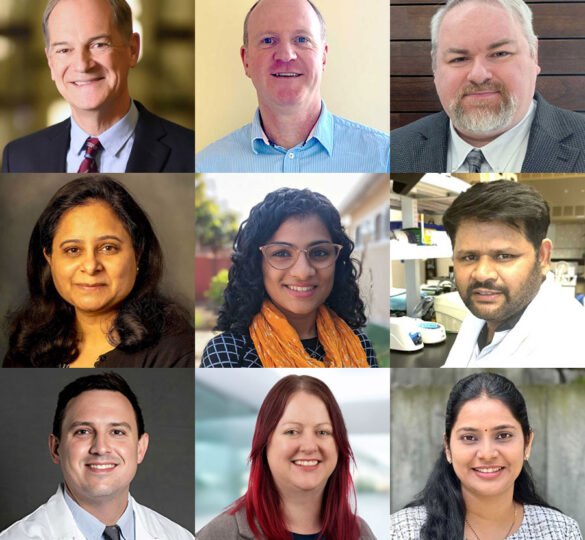Glaucoma Research Foundation Announces the 2025 Shaffer Grants for Innovative Glaucoma Research
“These one-year incubator grants attract much-needed brainpower to the field of glaucoma and move us ever closer to the discovery of new treatments to preserve and restore vision.”

March 19, 2025, SAN FRANCISCO, CA — Today Glaucoma Research Foundation (GRF) announced the nine recipients of its $55,000 one-year Shaffer Research Grants. GRF Shaffer Grants for Innovative Glaucoma Research present a unique opportunity for investigators to pursue innovative ideas in the spirit of high risk/high reward scientific discovery. 93% of surveyed Shaffer Grant recipients said that the GRF grant helped them pursue a new idea that would otherwise not have been investigated.
“We are extremely fortunate for the ongoing and generous investment from our glaucoma community which enables these promising areas of research to be explored,” said Thomas M. Brunner, GRF President and CEO. “These one-year incubator grants attract much-needed brainpower to the field of glaucoma and move us ever closer to the discovery of new treatments to preserve and restore vision.”
GRF is grateful to the generous donors who funded the 2025 Shaffer Research Grants.
The Arlene Anthony Grant for Innovative Glaucoma Research
Joel Palko, MD
West Virginia University School of Medicine
Project: Impact of Low Blood Pressure on ONH Biomechanics in Glaucoma
Summary: By uncovering the mechanisms linking low blood pressure to glaucoma, we aim to pave the way for new neuroprotective glaucoma treatments.
The Larry Haimovitch Grant for Innovation in Ophthalmology
Shruthi Karnam, PhD
University of California, Berkeley
Project: Targeting Lipoxin B4 for Reversing Astrocyte-Mediated Neuroinflammation in Glaucoma
Summary: This research project proposes a new approach to treating glaucoma by focusing on protecting retinal cells with anti-inflammatory strategies, rather than relying solely on reducing eye pressure.
The Mary Dell Hibbert Glaucoma Research Fund
Richard Eva, PhD
King’s College London
Project: Pro-Tect and Restore: Developing Pro-trudinPlus Gene Therapy
Summary: This project aims to develop a new gene therapy for glaucoma. It will also have relevance for other optic neuropathies and diseases of the central nervous system.
The Rajen Savjani Fund for Innovative Glaucoma Research
Vidhya Rao, PhD
Loyola University Chicago
Project: Role of Nicotinamide Adenine Dinucleotide Phosphate (NADPH) Oxidase-4 (NOX4) induced mitochondrial dysfunction in Primary Open Angle Glaucoma
Summary: We propose to determine if inhibiting NOX4 can prevent the increase in pressure within the eye. If successful, this study may lead to a new treatment strategy for the management of primary open-angle glaucoma.
The Rajen Savjani Fund for Innovative Glaucoma Research
Supraja Varadarajan, PhD
University of Texas Southwestern Medical Center
Project: The Role of Postsynaptic Targets in Preserving Vision
Summary: This proposal investigates the effect of modulating neural activity in target neurons on preventing glaucomatous retinal ganglion cell axon degeneration and conferring neuroprotection to target neurons.
The Linda and Gary Sirak Glaucoma Research Fund
Karl Kador, PhD
University of Missouri–Kansas City
Project: Reintroducing Developmentally Regulated Guidance Factors to the Optic Nerve
Summary: This study aims to develop a method for overcoming the lack of guidance of transplanted retinal ganglion cells, the first step in restoring vision to patients with late-stage glaucoma.
The Frank Stein and Paul S. May Grants for Innovative Glaucoma Research
Steven Barnes, PhD
Doheny Eye Institute, UCLA
Project: Intrinsic Ion Channels Reduce Excitability During Energy Stress
Summary: This project aims to improve diagnostics and detection to allow early intervention to prevent or restore vision loss due to ganglion cell loss in optic neuropathies including glaucoma.
The Frank Stein and Paul S. May Grants for Innovative Glaucoma Research
Fiona McDonnell, PhD
Moran Eye Center, University of Utah
Project: Extracellular Vesicle Regulation of ECM in the Lamina Cribrosa
Summary: Determining the role that extracellular vesicles play in extracellular matrix turnover in the lamina cribrosa will contribute to our knowledge of the mechanism leading to glaucoma progression and assess their potential as a treatment for this blinding disease.
The Zander Family Research Fund for Glaucoma Genetics
Balasankara Reddy Kaipa, PhD
University of California, Irvine
Project: The Genetics of Glaucoma: Lipid nanoparticle-mediated delivery of base editor ribonucleoprotein complex targeting the trabecular meshwork for the treatment of glaucoma
Summary: This project aims to develop a highly targeted, one-time gene therapy that directly addresses the disease’s root cause, providing hope for a lasting solution for patients suffering from MYOC-related glaucoma.
Since 1978, Glaucoma Research Foundation has invested more than $62 million to advance knowledge through innovative research. To date, GRF has awarded more than 300 Shaffer Research Grants. In addition to the Shaffer Grant program, GRF funds multiple “Catalyst for a Cure” collaborative, multi-year research initiatives aimed at restoring vision and accelerating better treatments and cures. To learn more, please visit www.glaucoma.org/research.
About Glaucoma Research Foundation
Founded in San Francisco in 1978, Glaucoma Research Foundation (GRF) is America’s oldest and most experienced institution dedicated solely to its mission: to cure glaucoma and restore vision through innovative research. GRF has a proven track record of ground-breaking, results-oriented research and produces definitive educational materials used by eye care professionals across the country. The Glaucoma Research Foundation website, www.glaucoma.org, provides valuable information about glaucoma to millions of visitors annually.
Pictured above: 2025 Shaffer Grant recipients clockwise from upper left: Steven Barnes, PhD, Richard Eva, PhD, Karl Kador, PhD, Balasankara Reddy Kaipa, PhD, Shruthi Karnam, PhD, Fiona McDonnell, PhD, Joel Palko, MD, Vidhya Rao, PhD, and Supraja Varadarajan, PhD (center).
Posted on March 19, 2025.